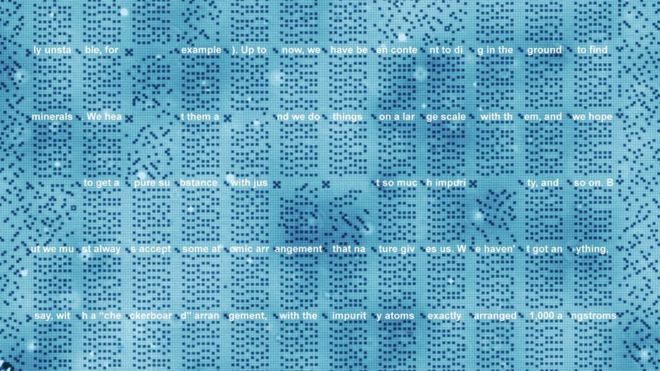导读:荷兰研究团队在已成功研发出能在超小型元件内存储大量信息的储存设备,其同等面积可储存的信息量相当于现有硬盘的500倍,理论上可在邮票大小的面积内存入全世界所有的书籍数据。

Dutch scientists developed rewritable memory that stores information in the positions of individual chlorine atoms on a copper surface.
荷兰科学家研发了一种重写存储器,原理是在铜质表面的单个氯原子上存储信息。
The information storage density is two to three orders of magnitude beyond current hard disk or flash technology.
这种信息存储的密度比目前的硬盘或闪存技术多出两到三个数量级。
Details of the advance appear in the journal Nature Nanotechnology.
这项先进技术的细节发表在了《自然纳米技术》期刊上。
The 1 kilobyte memory is the work of a team led by Sander Otte at the Technical University of Delft (TU Delft). with each bit of data represented by the position of a single chlorine atom, the team was able to reach a density of 500 Terabits per square inch.
这种1千字节的存储器是代尔夫特理工大学(TU Delft)桑德·奥特带领的团队的成果。通过单个氯原子的位置来表示每一比特数据,该团队达到了每平方英寸存储500TB数据的目的。
"In theory, this storage density would allow all books ever created by humans to be written on a single post stamp," said Dr Otte.
“从理论上讲,这种存储密度相当于把人类有史以来的所有书籍写在一张邮票上。”奥特博士说。
Or, by another measure, the entire contents of the US Library of Congress could be stored in a 0.1mm-wide cube.
换句话说,他们研发的设备能够在一个0.1mm宽的立方体中储存整个美国国会图书馆的数据。
The researchers used a scanning tunneling microscope (STM), in which a sharp needle probes the atoms on the surface one by one.
研究人员利用扫描隧道显微镜(STM),用一根尖锐的针在探测表面一个一个地探测原子。
This allowed the researchers to push the atoms around in a manner which Sander Otte compares to a sliding puzzle.
桑德·奥特说,这使得研究人员可以像万滑动拼图那样移动原子。
"Every bit consists of two positions on a surface of copper atoms, and one chlorine atom that we can slide back and forth between these two positions," he said.
“每一比特包含铜原子表面上的两个位置和一个氯原子,我们可以在这两个位置之间来回滑动。”他说。
"If the chlorine atom is in the top position, there is a hole beneath it - we call this a 1. If the hole is in the top position and the chlorine atom is therefore on the bottom, then the bit is a 0."
“如果氯原子在顶部,下方就会存在空洞——我们称之为1。如果空洞在顶部,氯原子是底部,则该位为0。”
Because the chlorine atoms are surrounded by other chlorine atoms (except near the holes), they keep each other in place.
由于氯原子被其它氯原子包围(除了空洞附近),它们使彼此保持在原位。
For this reason, the team at TU Delft believe their method is much more stable than methods using loose atoms - and more suitable for practical data storage applications.
出于这个原因,代尔夫特理工大学团队相信他们的方法比使用松散原子的方法稳定得多——也更适合于实际的数据存储应用。
As a proof of principle, the team encoded a section of a famous lecture called "There’s plenty of room at the bottom" by the physicist Richard Feynman on an area 100 nanometres wide.
作为原则性的证据,该团队在一个100纳米宽的表面上编码了一段物理学家理查德·费曼的著名演讲《微小世界有很大的发展空间》。
However, despite its future promise, the approach is not ready for the real world just yet. Stable information storage could only be demonstrated at a temperature of 77 Kelvin (-196C) and the speed of single write and read processes is still slow - on the scale of minutes.
然而,尽管其未来前景可观,这种方法现在还不能推行。稳定的信息存储只能在77开尔文(-196℃)的温度下进行,单次的读写过程仍然过慢——要花费好几分钟。
However, said Dr Otte, "through this achievement we have certainly come a big step closer".
但是,奥特博士说,“通过这项成果,我们又向前迈进了一步。”
In an article published in the same issue of Nature Nanotechnology, Steven Erwin, from the Naval Research Laboratory in Washington DC, acknowledged the current limitations.
美国海军华盛顿研究实验室的史蒂夫·欧文发表在《自然纳米技术》上的文章探讨了同一个问题,承认了目前的局限性。
But he added: "It is important to recognise the significance of this accomplishment — a functioning high density atomic-scale memory device that will, at the very least, stimulate our imaginations towards the next such milestone."
但是他补充说:“一个正常运作的高密度原子级存储设备,最起码会激发我们的想象力,让我们走向下一个里程碑——承认这一成就的意义是很重要的。”







